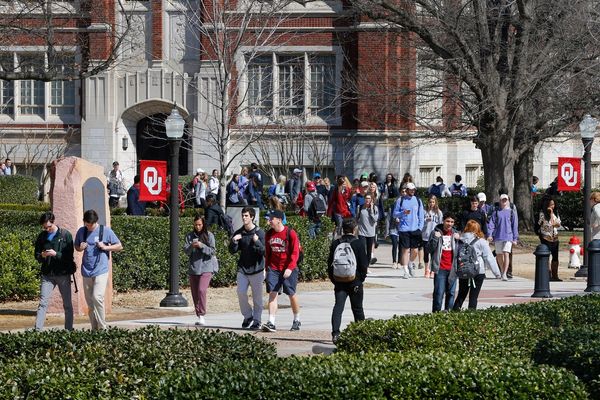SAN JOSE, Calif. — Gene Smith's comments didn't have time to settle before conclusions were drawn and criticism hurled.
The moment Ohio State's athletic director said last week that his peers in the Big Ten preferred to stick with a nine-game conference schedule, the Alliance with the ACC and Pac-12 was called into question.
A sampling of the headlines:
"Is the Alliance legit?"
"Is the Big Ten already abandoning the alliance with the Pac-12?"
"Is the Big Ten already leaving the Pac-12 and ACC out in the cold with the new alliance"
"Pac-12 Alliance with Big Ten, ACC takes a major hit"
Yes, the non-conference scheduling piece becomes more complicated if the Big Ten maintains a nine-game league rotation, for reasons we'll explain in a moment.
But guess what: That component was always secondary to the partnership's larger goals. On the issues that matter most, the Alliance has already been a major success, especially from the Pac-12's perspective.
Before we detail the issues specific to football, let's make note of an Alliance initiative already formalized: "Teammates for Mental Health," which is designed to raise awareness and create task forces to address mental health on all 41 Alliance campuses.
Mental health for athletes in all sports is the most important issue in college sports that gets the least attention, and it's not close.
Any campus-level endeavors that raise awareness and lend support — that make athletes realize it's OK to not be OK — is a victory, whether it's announced by a single conference or a group of leagues.
Mentioning that piece was essential.
Now, let's dig into the football-specific components to the Alliance, a non-binding agreement formed last summer by the three newest commissioners within the Power Five: The Big Ten's Kevin Warren (start date: Jan. 2020); the ACC's Jim Phillips (Feb. 2021); and the Pac-12's George Kliavkoff (July 2021).
Here we go ...
The scheduling piece
While perhaps the most intriguing component, this is the least important of the three we'll outline.
The logistics of scheduling an Alliance series would be vastly easier if the Big Ten drops to eight conference games. The Pac-12 would do the same, immediately, and the holes created would be filled with intersectional matchups scattered throughout the season — a clean, simple one-for-one swap.
(The ACC already plays eight conference games.)
Some Alliance matchups have been on the books for years — they went under contract before the partnership was created. And more will be added in future years even if the Big Ten sticks with nine league games. (Discussions are ongoing, in fact.)
The process will simply take longer to implement because so many teams have their non-conference slots filled for the next six or eight years.
The playoff piece
The most tangible impact of the Alliance thus far has been to slow the College Football Playoff expansion process.
Recall the events of last summer: A month before Texas and Oklahoma formally jumped to the SEC, the CFP went public with a 12-team proposal.
SEC commissioner Greg Sankey was one of the four CFP members on the subcommittee that crafted the proposal. The Pac-12, Big Ten and ACC were not part of the process. While on subcommittee, Sankey was negotiating with Texas and Oklahoma to join his league.
(To be fair to Sankey: Every other commissioner would have done the same if given the chance. Nonetheless, it created massive tension.)
The Alliance conferences never portrayed themselves as a potential voting bloc, but the philosophical alignment of three leagues not involved in the expansion process created a natural headwind. The resistance had strength in numbers as each commissioner pursued his agenda.
Those agendas have played out over the past six months, culminating with all three conferences formally voting against expansion last month in Indianapolis — a vote that effectively ended any hope of a 12-team playoff during the current contract term (through the 2025 season).
The ACC was against expansion in any form; the Pac-12 was in favor of the various formats but had concerns about the Rose Bowl's role and the revenue distribution; and the Big Ten insisted on a format that would provide automatic qualifiers for the champions of the Power Five conferences.
While one conference had the power to block expansion at any point through the 2025 season, the politics of the lone-holdout approach were fraught. But multiple leagues in opposition provided cover for the individual votes — even if Phillips, Kliavkoff and Warren were simply carrying out the wishes of their specific stakeholders.
And by stakeholders, we don't just mean the member universities.
The decision to block expansion has been portrayed publicly as a risky move by the three leagues, one that could lead the SEC to playing hardball (or harder-ball) during upcoming negotiations for expansion in the 2026 season and beyond.
But to a certain extent, that's viewing CFP politics as checkers while the sport's key media entities, ESPN and Fox, are playing chess.
Why did the SEC want expansion sooner than later? Perhaps because ESPN will be all-in financially with the SEC once Texas and Oklahoma join the league, and ESPN would own exclusive rights to an expanded playoff within the current contract term (through 2025).
It's easy to see where this was moving, right? In June, the CFP was barreling toward expansion on a timeline that suited ESPN contractually, and in July, news broke that the SEC — and by extension, ESPN — was adding Texas and Oklahoma.
Concern over ESPN's growing hegemony was rampant and, in our view, a critical reason for the formation of the Alliance — particularly from Fox's point of view.
And guess which league is deeply tied to Fox through its Tier I rights agreement and its conference network? The Big Ten.
Why might the Big Ten hold out for automatic bids for the Power Five champions knowing full well that it could kill any possibility of expansion during the current contract term?
Just our guess, but perhaps because Fox doesn't want ESPN to own the exclusive rights to the event — even for the final two years of the current term (2024-25).
Delay expansion until 2026, and ESPN has no advantage over Fox. There's an open bidding process starting with Year One of the expanded event.
To be clear: We aren't suggesting that the conferences are simply pawns for the grandmasters at ESPN and Fox.
The ACC has very real concerns over the state of college sports and the physical toll on the athletes of an expanded playoff.
The Pac-12's commitment to the Rose Bowl and, especially, the desire for transparency in the revenue distribution process are entirely legitimate.
But to ignore the ESPN and Fox influence, particularly as it relates to their two most lucrative partnerships — with the SEC and Big Ten, respectively — strikes us as a serious miscalculation.
The security piece
For the Alliance, and the Pac-12 in particular, this was the mountaintop.
The commissioners addressed the realignment issue during their news conference to unveil the partnership. They "felt a responsibility to stabilize a volatile environment."
Specifically, they wanted to provide a foundation for the Big 12 to regroup from the loss of Texas and Oklahoma and move forward.
By securing pledges of stability from the 41 university presidents, the Alliance effectively squashed the potential for additional realignment at the top of the college football power structure. The three leagues said to the Big 12: We aren't poaching your remaining schools; proceed as you wish.
But from the Pac-12's perspective, there was additional value to the Alliance: Securing its own future.
As soon as realignment in the Southern Plains shook the landscape, Kliavkoff's primary mission was to protect his membership.
From what? From the Big Ten casting an eye westward and dangling an invitation in front of USC and, perhaps, UCLA, Oregon and Washington, as well.
Any philosophical agreement that drew the Big Ten presidents closer to their peers in the Pac-12, via pledges of stability, would inherently help secure the survival of the Pac-12.
In our opinion — and we have believed this since whatever day Kliavkoff first discussed the Alliance with Warren and Phillips — the tripartite agreement has been, first and foremost, a defensive measure for the Pac-12.
As Washington State president Kirk Schulz, a veteran of realignment from his tenure at Kansas State a decade ago, told us last summer:
"You have got to hold serve at home."
And in that regard — in the most essential, existential regard — the Alliance was a stroke of genius.







